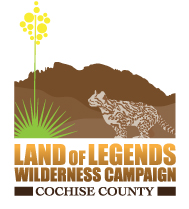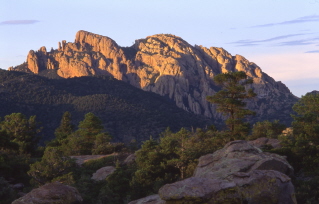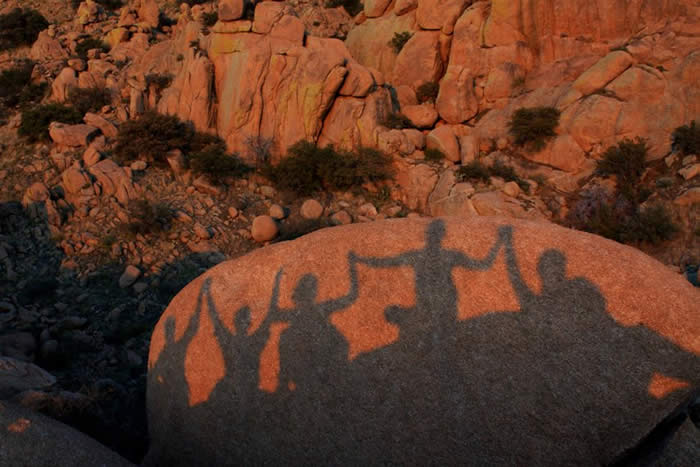|
|
Sky Island Region
Our Regional Work: Land of Legends Campaign
Protecting the Mystique, Beauty, and Ecology of the Sky Island Bioregion
Tumacacori Highlands | Species Diversity | Cultural History | Recreational Opportunities | Get Involved
 
The Dragoon, Chiricahua, and Whetstone Mountains of southeast Arizona are known as mystical, wild places where one can peek into a world gone by. Whether it's the outstanding natura heritage or rich Apache history one looks for, these mountains have it all except one thing; wilderness protection.
AWC is participating in a new effort to consider conservation approaches to preserve the natural and wilderness heritage of the Sky Island region. Long-term success in preserving natural values at a landscape scale will require consideration of diverse community interests, including landowners, business owners, the military, wildlife and all those who love this region. While our goals focus on preserving wilderness areas as described below, we recognize that effective conservation will draw on a variety of tools and approaches that can accommodate diverse community needs.
 Wild Remnants of Arizona Wild Remnants of Arizona
The Sky Island region of southeastern Arizona is one of the most biologically diverse areas in North America, where the temperate and tropical zones meet, and North America's two major deserts convene. Here, more species of mammals, birds, reptiles, bees and ants are found here than any other place in the country! The ecological richness of these mountainous "island" habitats is equally matched by the cultural splendor found throughout Cochise County. For instance, the Dragoon Mountains host the site where, in 1872, General Otis Howard negotiated the first and last treaty with the Chiricahua Apaches, granting them all of southeast Arizona as tribal lands, only to be retracted four years later. Cochise County is a vibrant corner of Arizona, where dreams were made, many dashed, and all of it reflected in the land and relics that lie upon it.
Urgent Action is Needed
Arizona's population grew nearly 30% between 2000 and 2010, with similar trends in Cochise County. What's more, the Sky Islands are easily fragmented by roads and development because of their isolated nature. As such, the Coronado National Forest of southeastern Arizona has the highest number ofthreatened and endangered species of all National Forest lands in the country. By supporting wilderness and other conservation designations for Cochise County's wild lands, you help safeguard the region's clean air and water, quiet recreational opportunities, and the irreplaceable cultural fabric that has defined the county for centuries.
Species Diversity
 The Sky Islands are forested mountain ranges surrounded by seas of desert and grassland. The Blue Range to the north is a huge expanse of highlands typified by ponderosa pine forests, unfragmented habitat, and the largest remaining roadless area in the state. Serving as an intersection between the Rocky Mountains and the Sierra Madres, these mountains and their lush watered canyons provide breathtaking views, superior wilderness adventures, and biological strongholds for a wide array of temperate and tropical species.
The Sky Islands are forested mountain ranges surrounded by seas of desert and grassland. The Blue Range to the north is a huge expanse of highlands typified by ponderosa pine forests, unfragmented habitat, and the largest remaining roadless area in the state. Serving as an intersection between the Rocky Mountains and the Sierra Madres, these mountains and their lush watered canyons provide breathtaking views, superior wilderness adventures, and biological strongholds for a wide array of temperate and tropical species.

Because of the Sky Island's geographical location at the crossroads of the temperate and sub-tropical realms, rare species found nowhere else in the United States occur here. The elegant trogon, gray hawk, buff-collared nightjar, and thick-billed parrot are just a small sample of the birds found in the Sky Islands. Jaguars, coatis, and other unique, tropically-oriented mammals call the Sky Islands home. Large tracts of roadless and wilderness lands are essential to the survival of many of these spectacular species – together, we work to preserve our natural heritage.
Cameras Help Us Find Critical Wildlife Corridors
Watch our short video on wildlife tracking cameras in the Whetstone Mountains to better understand wildlife movement in the Sky Island region. Watch it now!
[back to top]
Cultural History

This figurine was modeled in clay
over a thousand years ago by an
artisan living along the San Pedro
River of southeastern Arizona.
Credit: Center for Desert Archaeology
Humans have inhabited the Sky Island region for thousands of years. In present-day Tucson on the banks of the Santa Cruz River, archeologists have concluded that sites found there represent the oldest, continuously inhabited area in the United States. The Sky Island region, in more recent times, has mirrored the historical range of the Chiricahua Apaches, the most famous of Apache tribes. Because of conflict between Spanish and western European settlers, the Apaches were successful in delaying settlement of the region for 150 years.
It wasn't until 1886 that the great warrior Geronimo surrendered for the last time to General Miles in the Peloncillo Mountains. Until that time, southeastern Arizona remained largely a wilderness occupied by few people who dared to eke out a living in fear of raids. Today, an incredible amount of archeological sites dot the landscape, reminding us of those who walked before our time.
[back to top]
Recreational Opportunities
Hiking and backpacking, whether in the pine-clad Chiricahuas, rose-colored Dragoons, or elsewhere, is extremely popular. The Arizona Trail, originating at the Mexican Border south of the Huachuca Mountains, travels through the region offering visitors a wide range of outdoor experiences. Starting on one trail, hikers may begin in upper Sonoran Desert and travel through 6 distinct vegetation zones before resting in spruce-fir forests at higher elevations. Horseback riding, photography, nature watching, and hunting are all popular recreational activities compatible with wilderness designation.
Southeastern Arizona is known worldwide for its unparralled bird watching opportunities. Birdwatchers from all corners of the globe seek out five-striped sparrows, blue grosbeaks, Mexican chickadees, over 18 species of hummingbirds, and many more.
Get Involved
As most of the work accomplished here and elsewhere depends heavily on the participation of volunteers, you can directly get involved in our exciting fieldwork. While surveying areas for potential wilderness, participants experience landscapes that are little traveled, beautiful, and remote.
The Arizona Wilderness Coalition newsletter and Sky Island Alliance website provide regular updates on volunteer opportunities, action alerts, and exciting information that will involve you in the protection of our natural heritage.
To learn more and to volunteer, please contact us at 520-326-4300.
[back to top]
 
|





